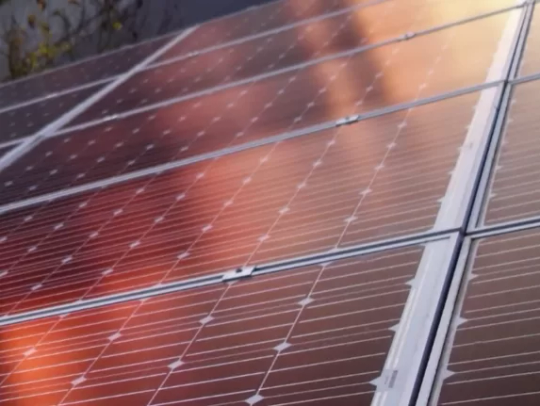#solarcellefficiency
Explore tagged Tumblr posts
Text
Solar Panels Energy Transformation - How Sunlight Becomes Electricity

Solar Panels Energy Transformation: How Solar Panels Work The phrase solar panels energy transformation refers to the fascinating process of converting sunlight into usable electricity. It’s a marvel of modern technology, but understanding it can seem complex. Are you curious about how sunlight powers homes and businesses? Let’s break it down simply and clearly. What Problem Do Solar Panels Solve? Energy demand is skyrocketing, and traditional fossil fuels are both limited and harmful to the environment. Solar energy provides a sustainable, eco-friendly alternative. However, many wonder: how does sunlight turn into the electricity that powers our devices? This guide explains the step-by-step transformation, highlighting the science and technology behind it.

H2: What Is Solar Energy Transformation? Solar energy transformation is the process of converting photons from sunlight into electrical energy through photovoltaic (PV) technology. Solar panels, made up of numerous solar cells, are the heart of this process. Step-by-Step Process of Solar Panels Energy Transformation Capturing Sunlight Through Photovoltaic Cells Solar panels contain photovoltaic cells made from semiconductors, typically silicon. When sunlight hits the panel, photons excite the electrons in the semiconductor material, creating an electric current. This phenomenon is called the photoelectric effect. Creating an Electric Field Each solar cell is designed with two layers: one positively charged and one negatively charged. This setup creates an electric field, forcing the excited electrons to move, generating a flow of electricity. Direct Current (DC) to Alternating Current (AC) Conversion The electricity generated by the solar cells is in direct current (DC) form. An inverter is used to convert DC to alternating current (AC), which is the standard electricity type for powering homes and businesses. Powering Your Home or Sending Energy to the Grid Once the energy is converted to AC, it can power your appliances or be stored in batteries for later use. Any excess electricity can be sent to the grid, often earning homeowners credits through net metering. Benefits of Solar Panels Energy Transformation - Renewable Resource: Solar power harnesses an unlimited energy source—the sun. - Eco-Friendly: No harmful emissions or pollutants are released. - Cost Savings: Lower electricity bills and potential earnings from excess energy production. - Energy Independence: Reduce reliance on traditional utilities. Frequently Asked Questions About Solar Energy Transformation How Efficient Are Solar Panels? Modern solar panels can convert around 15-22% of sunlight into electricity. Efficiency depends on factors like location, panel quality, and weather conditions. Can Solar Panels Work on Cloudy Days? Yes, though their efficiency decreases. Panels still generate electricity from diffuse sunlight, but production will be lower than on sunny days. What Happens to Solar Panels at Night? At night, when sunlight isn’t available, energy stored in batteries or sourced from the grid is used to meet electricity needs. Solar Panels Energy Transformation - Solar Energy Here to Stay The transformation of solar energy into electricity is paving the way for a sustainable future. With advancements in technology, solar panels are becoming more efficient, affordable, and accessible. By understanding this process, you can make informed decisions about embracing solar energy for your home or business. Ready to learn more about the benefits of solar energy? Explore installation guides, financial incentives, technology trends, and Solar Gadgets today. Read the full article
#eco-friendly#energyindependence#photoelectriceffect.#renewableresource#solarcellefficiency#solarcells#solarpanels#SolarPanelsEnergyTransformation
0 notes
Text
Perovskite Solar Cells: The Next Big Leap in Renewable Energy
Did you ever find yourself pondering on a sunny day how much energy we could harness if we effectively tapped into the sunlight bathing our planet? The answer: a lot! And, to reach this energy utopia, advancements in solar cell technology are key. One particular technology showing immense promise is the Perovskite Solar Cell. Read on to grasp why scientists and energy enthusiasts are buzzing about this!

What is Perovskite?
Brief history and origin Don't get intimidated by the term "Perovskite" - it's just a type of mineral, first discovered in the Ural Mountains of Russia in the 19th century and named after the Russian mineralogist L.A. Perovski. Unique properties Perovskite, specifically the synthetic version used in solar cells, has a special crystallographic structure. This structure grants it fantastic light-absorbing properties and makes it a superstar in the world of photovoltaics.
What are Solar Cells?
How do they work? Think of solar cells as tiny power factories. They convert sunlight into electricity using a process called the photovoltaic effect. When sunlight strikes the cell, it energizes the electrons, causing them to move and generate electricity. Introduction to Perovskite Solar Cells Understanding the mechanism A Perovskite Solar Cell uses the unique properties of perovskite crystals to absorb sunlight and generate electricity. Just like a sandwich, the perovskite layer is nestled between other layers, each with a specific purpose, in order to create an efficient solar cell.
Advantages of Perovskite Solar Cells
Perovskite Solar Cells come with a host of benefits that are making traditional solar cells sweat: Improved efficiency Perovskite solar cells are giving traditional solar cells a run for their money, with lab efficiencies reaching over 25%. That's a major step up from the early days of perovskite cells, where efficiencies were only around 4%. Lower cost They're potentially cheaper to produce than their silicon counterparts. The reason? Perovskite can be manufacturedusing simple and inexpensive techniques, which is music to the ears of manufacturers and consumers alike. Flexibility Perovskite cells can be made flexible, lightweight, and semi-transparent, opening up possibilities for integrating them into buildings, vehicles, and even clothing.
Challenges and Solutions
Just like any budding technology, Perovskite Solar Cells are not without their growing pains. Here are some of the challenges they face: Stability issues These cells are not as long-lasting as traditional solar cells due to their sensitivity to moisture, heat, and UV light. However, researchers are continuously working on encapsulation techniques to protect the perovskite layer and enhance the cell's lifespan. Toxicity concerns The most efficient perovskite solar cells contain lead, raising toxicity concerns. Yet, don't worry! Scientists are actively exploring lead-free alternatives.
Current research trends
To address these challenges, intense research is ongoing globally, with scientists investigating new perovskite compositions, novel cell architectures, and advanced fabrication techniques. Impact on the Renewable Energy Sector With their potential, Perovskite Solar Cells are set to make waves in the renewable energy sector. Potential market disruption Due to their low cost and high efficiency, these solar cells could shake up the solar energy market, making solar power more affordable and accessible to the masses. Future predictions If current research trends continue, we could see a future where perovskite solar cells are common, not just in solar farms but in everyday products too.
Conclusion
Perovskite Solar Cells represent a significant leap forward in renewable energy technology. While there are challenges to overcome, the future looks bright for this innovative technology. It may not be too long before we see these high-performing, cost-effective solar cells helping to power our homes, cities, and possibly even our world.
Frequently Asked Questions (FAQs)
What is the efficiency of Perovskite Solar Cells? Lab efficiencies of perovskite solar cells have reached over 25%. However, efficiencies can vary depending on the specific composition and structure of the cell. Are Perovskite Solar Cells commercially available? While significant strides have been made in research and development, commercial availability of perovskite solar cells is still limited due to issues like stability and lead toxicity. Can Perovskite Solar Cells replace traditional silicon cells? In the future, it's possible! With their high efficiency and lower potential cost, they present a compelling alternative to silicon cells. Are Perovskite Solar Cells environmentally friendly? The main environmental concern regarding perovskite solar cells is the use of lead in their composition. However, scientists are exploring lead-free alternatives to address this issue. How long do Perovskite Solar Cells last? Currently, their lifespan is not as long as traditional solar cells due to their sensitivity to certain environmental factors. But researchers are actively working to improve their stability and longevity. Read the full article
#futureofsolarenergy#Low-CostSolarPower#PerovskiteResearchandDevelopment#PerovskiteSolarCells#RenewableEnergyTechnology#SolarCellEfficiency
0 notes